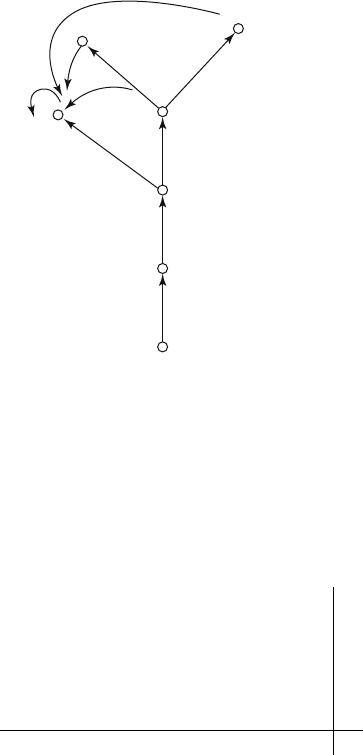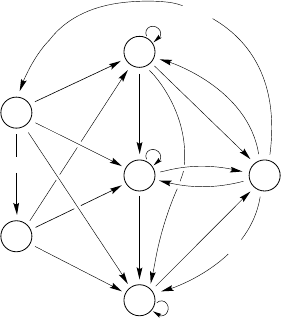Keyfitz N., Caswell H. Applied Mathematical Demography
Подождите немного. Документ загружается.

11
Markov Chains for Individual Life
Histories
The passage of an individual through its life cycle, from birth to death,
is marked by various notable events. Some, like maturation or mating or
reproduction, may be optional. Others, like death, are inevitable. A matrix
model contains a great deal of information (or, equivalently, makes many
strong assertions) about these events, their probabilities, and the sequences
in which they tend to occur. This chapter shows how to extract some of
the implications of these assertions. For example, what is the probability of
surviving from birth to maturity in a model where individuals may reach
maturity by many pathways? What is the average time required to mature?
What is the probability of experiencing an event (e.g., a disease, or attack
by a predator) before maturing, or before dying? Such questions can be
answered by describing the individual life cycle as a Markov chain. The re-
sults provide ways to calculate age-specific parameters from stage-classified
models.
11.1 A = T + F: Decomposing the Matrix
Most life cycles permit a distinction between the transitions of living indi-
viduals and the production of new individuals. Thus the projection matrix
can be written
A = T + F, (11.1.1)
where T describes transitions and F describes reproduction. The element
f
ij
of F is the expected number of type i offspring produced by an individual

246 11. Markov Chains for Individual Life Histories
in stage j. The element t
ij
of T is the probability that an individual in stage
j at time t is alive and in stage i at time t + 1. This decomposition has
been applied by Cochran and Ellner (1992) to density-independent models
and Cushing (1988, 1997, Cushing and Yicang 1994) to density-dependent
models.
11.1.1 The Life Cycle as a Markov Chain
We will describe the movement of an individual through its life cycle as a
Markov chain. The matrix T describes part of this movement, but it must
be augmented by adding an extra state, “dead.” If there are s stages, the
result is an s + 1 dimensional Markov chain with transition matrix
∗
P =
T
0
m 1
of dimension
s × s
s × 1
1 × s 1 × 1
. (11.1.2)
Here, m
j
=1−
i
t
ij
is the probability of death for stage j. State s +1
(death) is an absorbing state; once an individual enters this state, it never
leaves.
There is a sizeable literature on Markov chain models for movement
of individuals among social and occupational classes (e.g., Bartholomew
1982), some of which has been applied to demography (see Section 10.5).
Feichtinger (1971, 1973) applied these methods to age-classified models
with multiple absorbing states, first marriage models, and models for mul-
tiple classifications (age and parity, age and marital status). Cochran and
Ellner (1992) independently used Markov chains in an analysis of stage-
classified models. They also considered cases where F is divided into
separate matrices representing birth and fission.
The states in an absorbing Markov chain can be divided into two sets: a
set T of transient states and a set A of absorbing states; in this model
T = {1, 2,...,s}
A = {s +1}.
We will denote the number of elements in the set A by |A| (this is the car-
dinality of A). At this point, |A| = 1, but later we will add more absorbing
states. We assume (it is implicit in calling the set T transient) that there
is a pathway from each of the states in T to one of the states in A.That
is, there are no immortal stages in the life cycle. If there were, they would
appear as another set of absorbing states.
∗
To emphasize the parallel with population projection matrices, P has been written
as a column-stochastic matrix. Many texts on Markov chains would write it as a row-
stochastic matrix, equivalent to the transpose of the matrix listed here. Either way is
OK; just be careful to get the proper orientation of formulae presented in such texts.

11.1. A = T + F 247
Let x be a column vector giving the probability distribution of states,
where 0 ≤ x
i
≤ 1and
i
x
i
=1.Then
x(t +1)=Px(t) (11.1.3)
and
x(t)=P
t
x(0), (11.1.4)
where
P
t
=
T
t
0
m
t−1
n=0
T
n
1
. (11.1.5)
Our assumption that it is possible to reach the state “dead” from every
state in T guarantees that the dominant eigenvalue of T is strictly less
than 1; thus lim
t→∞
T
t
= 0 (Iosifescu 1980, Theorem 2.2). Thus (11.1.3)
leads to the basic result on absorbing Markov chains: No matter what the
initial probability distribution, the probability of the system being in any
state other than an absorbing state eventually approaches zero.
Example 11.1 Markov-chain decomposition for killer whales
The killer whale life cycle graph is given in Figure 3.10. Using vi-
tal rates estimated for the resident population in coastal waters of
Washington and British Columbia (Brault and Caswell 1993), the
decomposition of A yields
T =
⎛
⎜
⎜
⎝
0000
0.9775 0.9111 0 0
00.0736 0.9534 0
000.0452 0.9804
⎞
⎟
⎟
⎠
(11.1.6)
F =
⎛
⎜
⎜
⎝
00.0043 0.1132 0
00 00
00 00
00 00
⎞
⎟
⎟
⎠
. (11.1.7)
Because only one kind of offspring is produced, the fertility matrix F
contains only a single nonzero row. The transition matrix is
P =
⎛
⎜
⎜
⎜
⎜
⎝
0000
0
0.9775 0.9111 0 0
0
00.0736 0.9534 0
0
000.0452 0.9804
0
0.0225 0.0153 0.0014 0.0196 1.0000
⎞
⎟
⎟
⎟
⎟
⎠
. (11.1.8)
Example 11.2 From school to work.
Some of the considerations just mentioned can be illustrated by a
model of the school population and its emergence into the labor force

248 11. Markov Chains for Individual Life Histories
Technical
5
4
School –
grades 9 to 12
School –
grades 5 to 8
School –
grades 1 to 4
Preschool
1
2
3
7
6
College
Labor
force
Figure 11.1. Graph of progress through school system and points of emergence
into the labor force, along with corresponding matrix A, disregarding mortality
and repeating; projection interval = 4 years.
(Keyfitz 1977). Consider only the flows portrayed in the graph of
Figure 11.1. We ignore mortality, but in this model stage N
7
,the
labor force, is an absorbing state. The transient states are N
1
–N
6
.In
this case, there is no reproductive process, and the transition matrix
is
P =
⎛
⎜
⎜
⎜
⎜
⎜
⎜
⎜
⎜
⎝
00 0 0 00
0
10 0 0 00
0
01 0 0 00
0
00 p
43
000
0
00 0 p
54
000
00 0 p
64
000
001− p
43
1 − p
54
− p
64
111
⎞
⎟
⎟
⎟
⎟
⎟
⎟
⎟
⎟
⎠
(11.1.9)
11.1.2 The Analysis of Absorbing Chains
So far we have only stated the obvious: if every individual can die, every
individual eventually will die. Now we want to know what happens to
individuals en route to that end. The results summarized here are standard
in Markov chain theory; see Iosifescu (1980, Chap. 3) or Kemeny and Snell
(1976, Chap. 3) for full treatments.
Notation alert.IfX is any matrix, then X
dg
is the matrix with the
diagonal of X on its diagonal, and zeros elsewhere. The row sums of X are
Xe, and the column sums are e
T
X,wheree is a column vector of ones.
11.1. A = T + F 249
11.1.2.1 The Fundamental Matrix
The (i, j) entry of the matrix T
t
is the probability that an individual in
stage j at time 0 will be in stage i at time t,fori, j ∈T. Since absorption
is certain, these probabilities eventually decay to zero. But an individual
will visit various transient states, various numbers of times, before absorp-
tion happens. Let ν
ij
be the number of visits to transient state i before
absorption, given that the individual starts in state j. The expected values
of the ν
ij
are given by a matrix
E (ν
ij
)
= I + T + T
2
+ ··· (11.1.10)
=(I − T)
−1
(11.1.11)
≡ N. (11.1.12)
The matrix N is called the fundamental matrix of the Markov chain.
The second moments of the ν
ij
are
E
/
ν
2
ij
0
=(2N
dg
− I) N (11.1.13)
(Iosifescu 1980). Thus the variance of the number of visits to each state is
given by the matrix
V (ν
ij
)
=(2N
dg
− I) N − N ◦ N, (11.1.14)
where ◦ denotes the Hadamard, or element-by-element, product.
The fundamental matrix provides information about the time to absorp-
tion (i.e., to death). Let the time to absorption, starting in transient state
i,beη
i
. The mean of η
j
is the sum of column j of the fundamental matrix
N (i.e., the number of visits to all the transient states)
E (η
1
) ··· E (η
s
)
= e
T
N. (11.1.15)
Iosifescu shows that the second moments of the η
j
are given by
E
/
η
2
1
0
··· E
/
η
2
s
0
= e
T
N (2N − I) . (11.1.16)
Thus the variance of time to absorption can be written
V (η
1
) ··· V (η
s
)
= e
T
/
2N
2
− N
0
− e
T
N ◦ e
T
N. (11.1.17)
We can calculate not only the mean but the complete probability distri-
bution of the η
j
. The entries of T
t
give the probabilities of being in each
of the transient states at time t. Thus the sum of column j of T
t
is the
probability that absorption has not occurred by time t, starting from state
j.Thus
P [η
1
>t] ··· P [η
s
>t]
= e
T
T
t
. (11.1.18)

250 11. Markov Chains for Individual Life Histories
Since P [η
i
= t]=P [η
i
>t− 1] − P [η
i
>t], we obtain the probability
distribution for the times to absorption
P [η
1
= t] ... P [η
s
= t]
= e
T
(T
t−1
− T
t
). (11.1.19)
11.1.2.2 Probabilities of Absorption
So far we have assumed only a single absorbing state (death). It is some-
times useful to consider models with multiple absorbing states, in which
case
P =
T
0
M I
, (11.1.20)
where M is a matrix whose entries m
kj
give the probability of moving from
state j ∈T to the kth absorbing state in A. Every individual will end up
in an absorbing state, but which absorbing state is uncertain. We would
like to calculate the probabilities
b
kj
= P [absorption in k|starting in j]1≤ k ≤|A|,j∈T. (11.1.21)
We know that if the system starts in transient state j it spends an average
of n
ij
time steps in transient state i (where i ∈T). At each of these time
steps, the probability of moving to the kth absorbing state is m
ki
.Thus
b
kj
=
i∈T
m
ki
n
ij
1 ≤ k ≤|A| (11.1.22)
or, in matrix notation
B = MN. (11.1.23)
11.1.2.3 Probabilities Conditional on Absorption
If more than one absorbing state exists, we can calculate probabilities con-
ditional on which of those states an individual ends up in. For example,
we might describe mortality and emigration as absorbing states. We could
compare the properties (e.g., mean time before leaving the population) of
individuals that emigrate versus those that die before emigrating. We do
this by creating a new transition matrix, conditional on absorption in a
particular state.
Suppose we condition on absorption in the kth absorbing state. The state
space of the resulting Markov chain is the set T of transient states plus the
kth absorbing state. The transition matrix for this new conditional Markov
chain is
P
(c)
=
T
(c)
0
m
(c)
1
, (11.1.24)

11.2. Lifetime Event Probabilities 251
where the superscript c denotes the conditional chain. Bayes’ theorem
†
implies that the conditional probabilities can be written in terms of the
matrix M and the matrix B calculated from P:
t
(c)
ij
=
t
ij
b
ki
b
kj
(11.1.25)
m
(c)
j
= m
kj
/b
kj
(11.1.26)
or, in matrix notation,
T
(c)
= DTD
−1
, (11.1.27)
where, letting b
k·
denote the kth row of B,
D = diag(b
k·
)=
⎛
⎜
⎝
b
k1
b
k2
.
.
.
⎞
⎟
⎠
. (11.1.28)
The fundamental matrix for the conditional chain is
N
(c)
= DND
−1
. (11.1.29)
It can be used like any fundamental matrix.
We turn now to several important applications of these results.
11.2 Lifetime Event Probabilities
At any stage in its life cycle, an individual is embarking on a developmental
process that will eventually end in death. At each step of that process, the
individual experiences the risk of various events (e.g., contracting a disease,
or attack by a predator). The probability that an event occurs at least once
in the individual’s lifetime may be of interest in a variety of contexts. For
example:
• The plant Lomatium grayi is attacked by a moth called Depressaria
multifidae. Lomatium grows through a series of size classes, alter-
nating between vegetative and flowering condition. The probability
of attack by Depressaria is stage-dependent. Thompson and Moody
(1985) wanted to know the probability that a new seedling will be
attacked by the moth at least once during its lifetime. They inter-
pret this probability as a measure of the “apparency” of the plant to
its herbivore. It has been suggested that apparency should determine
the type of chemical defenses that a plant deploys against a herbivore
(Feeney 1976).
†
For any two events X and Y , P [X |Y ]=P [X and Y ]/P[Y ], provided that P [Y ] > 0.
252 11. Markov Chains for Individual Life Histories
• The U.S. Department of Justice has calculated the probability that
a 12-year-old American will experience certain kinds of violent crime
in his or her lifetime (Koppel 1987). The probabilities were 0.83 for
all types of violent crime, 0.99 for personal theft, 0.74 for assault,
0.30 for robbery, and 0.08 for rape (the latter figure for women).
These lifetime probabilities are presented as better measures of the
true risk of these crimes than annual incidence statistics (“If the earth
revolved around the sun in 180 days, all our annual crime rates would
be halved, but we would not be safer.” Koppel 1987)
• Bone fractures are a significant health risk to postmenopausal women.
Cummings et al. (1989) found that the lifetime probability of hip
fracture for a 50-year-old U.S. woman was 0.156. The corresponding
probabilities for wrist fractures and atraumatic vertebral fractures
were 0.15 and 0.32. Combining these probabilities with estimates of
the mortality due to these injuries, they concluded that the lifetime
risk of death from hip fracture was comparable to that from breast
cancer. Such comparisons might be useful in comparing the risks and
benefits of therapies designed to reduce osteoporosis.
In each of these cases, the lifetime probability is affected by both the risk
of the event and the demography. The lifetime probability of hip fracture
could be lessened by reducing the risk of falling (e.g., by studying t’ai chi
chuan; Wolf et al. 1996) or by increasing mortality, so that fewer women
survive to ages where falls are more frequent. The former strategy is ob-
viously preferable, but in more complex life cycles the choices might be
less plain. Lomatium grayi might, for example, want to consider whether it
should try to prevent Depressaria attack, or adjust its life cycle to spend
less time in stages particularly vulnerable to attack.
Chiang (1968) shows how to calculate lifetime risks from age-classified
life tables. Here we compute these probabilities from stage-classified models
using the Markov chain description of the life cycle. We begin with the basic
structure (11.1.2) and add an additional absorbing state, “event-before-
death.” Because we are interested only in the probability of experiencing
the event, what happens to an individual after the event is irrelevant (of
course, it may be very relevant for other questions). Thus we can simply
leave individuals who have experienced the event in “event-before-death”
and not worry about them further.
Let α
i
be the probability that an individual in stage i experiences the
event in the interval (t, t + 1]. Carry out the following procedure.
1. Create a new matrix T
describing transitions of individuals that
neither die nor experience the event. Its entries are
t
ij
=(1− α
j
) t
ij
i, j ∈T. (11.2.1)

11.3. Age-Specific Traits From Stage-Specific Models 253
2. Create a new matrix M
containing the probabilities of transition
from each transient state to the two absorbing states
m
ij
=
'
(1 − α
j
) m
j
i =1,j∈T
α
j
i =2,j∈T
(11.2.2)
The new transition matrix is
P
=
T
0
M
I
. (11.2.3)
3. Use the methods of Section 11.1.2.2 to compute the probability of
absorption in each of the two states.
B = M
(I − T
)
−1
. (11.2.4)
The lifetime event probability is the probability of absorption in
“event-before-death,” which is given by the second row of B.
11.3 Age-Specific Traits From Stage-Specific
Models
In a stage-classified model, the ages of individuals are not known, but it
is possible to calculate age-specific survivorship and fertility, mean age at
first reproduction, net reproductive rate, generation time, and age-within-
stage distributions directly from the Markov chain describing the life cycle.
We will focus on two examples. One is the stage-structured model for
killer whales (Brault and Caswell 1993; see Example 11.1), because an
independent age-classified analysis exists for comparison (Olesiuk et al.
1990).
The second example is a stage-structured model for teasel (Dipsacus
sylvestris). Teasel is a weedy plant, introduced to North America from
Europe in the late nineteenth century. Seeds germinate to form flattened
rosettes, which grow until they reach a critical size, at which point they
flower and die. Seeds may remain dormant for up to a few years. A variety
of evidence pointed to size as the critical i-state variable, so Werner and
Caswell (1977, Caswell and Werner 1978) developed size-classified models
whose entries corresponded to the life cycle graph of Figure 11.2. Because
the projection interval was one year, reproduction in year t can produce
small, medium, or large rosettes in year t+1. The production of more than
one kind of offspring is not common in human demographic models, but it
might appear in analyses of infant mortality or of family development; it is
not uncommon in ecological applications, and this example will show how
to account for it in calculations.

254 11. Markov Chains for Individual Life Histories
3
1
2
46
5
.013
30.170
0
.010
322.38
.966
.007
.008
Dormant
seeds
Rosettes
Flowering
0
.862
3.448
Dormant
seeds
Figure 11.2. A life cycle graph for teasel (Dipsacus sylvestris). Stages: N
1
=
first-year dormant seeds, N
2
= second-year dormant seeds, N
3
= small rosettes,
N
4
= medium rosettes, N
5
= rosettes, and N
6
= flowering plants.
Example 11.3 Markov chain decomposition for teasel
The population projection matrix for teasel is composed of transition
and fertility matrices
T =
⎛
⎜
⎜
⎜
⎜
⎜
⎜
⎝
000000
0.96600000
0.013 0.010 0.125 0 0 0
0.00700.125 0.23800
0.00800.038 0.245 0.167 0
0000.023 0.750 0
⎞
⎟
⎟
⎟
⎟
⎟
⎟
⎠
(11.3.1)
F =
⎛
⎜
⎜
⎜
⎜
⎜
⎜
⎝
00000322.388
00000 0
00000 3.448
00000 30.170
00000 0.862
00000 0
⎞
⎟
⎟
⎟
⎟
⎟
⎟
⎠
. (11.3.2)
ThesixthcolumnofT is zero because flowering plants all die after
reproduction. The nonzero entries in the sixth column of F give the
production of different kinds of offspring (first-year dormant seeds
and small, medium, and large rosettes). The resulting Markov chain
